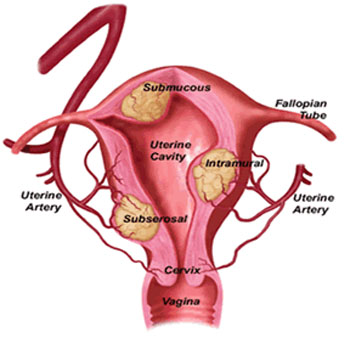Uterine Fibroids - symptoms and treatment

What are Uterine Fibroids
Uterine Fibroids - Benign (noncancerous) tumors of connective tissue and MUSCLE that grow from the walls of the UTERUS. Uterine fibroids, also called uterine leiomyomas or fibromyomas, may grow inward into the inner cavity of the uterus (submucosal fibroids), within the layers of the myometrium (muscular wall of the uterus), or outward from the myometrium into the abdominal cavity (subserosal fibroids). Pedunculated fibroids grow on stalks and can be submucosal or subserosal.
Uterine fibroids are very common. They may occur as isolated or clustered growths ranging in size from barely visible to the eye to as big as grapefruit. Uterine fibroids may cause symptoms when they press against other abdominal structures such as the BLADDER or RECTUM, when a pedunculated fibroid twists on its stalk, or when a fibroid dies and releases fluid and debris that irritates the surrounding tissues.
Symptoms of Uterine Fibroids and Diagnostic Path
Three fourths of women who have uterine fibroids have no symptoms; the doctor detects the fibroids during routine PELVIC EXAMINATION or ULTRASOUND performed for other reasons. When symptoms occur they often include
- low abdominal (pelvic) pressure or PAIN that often intensifies during MENSTRUATION
- heavy or prolonged menstrual bleeding
- bleeding between menstrual periods
- CONSTIPATION or DIARRHEA
- pain in the lower back or the upper legs
Uterine fibroids may also create FERTILITY problems when they are large enough or when they grow in positions, especially near the openings of the FALLOPIAN TUBES, that prevent the implantation of a fertilized egg (ZYGOTE). Large fibroids may interfere with the growth of the FETUS, causing spontaneous ABORTION (miscarriage).
The diagnostic path includes pelvic examination and imaging procedures such as ultrasound, COMPUTED TOMOGRAPHY (CT) SCAN, or MAGNETIC RESONANCE IMAGING (MRI). The doctor may also perform HYSTEROSCOPY to view the inner uterus or laparoscopy to view the abdominal cavity. These procedures, performed with ANESTHESIA, also allow the doctor to also take small samples of the growths for further laboratory analysis.
Uterine Fibroids Treatment Options and Outlook
Uterine fibroids that do not cause symptoms do not require treatment. Often, uterine fibroids shrink on their own with MENOPAUSE and then cease to cause symptoms. Medical treatments include
- NONSTEROIDAL ANTI-INFLAMMATORY DRUGS (NSAIDS), which effectively relieve the discomfort of uterine fibroids when symptoms are mild
- hormones such as GONADOTROPIN-RELEASING HORMONE (GNRH) agonists (such as leuprolide) and ANDROGENS (such as Danocrine) that alter the hormonal balance in the body, causing the fibroids to shrink
- oral contraceptives (birth control pills), particularly progestin-only products, which may reduce symptoms with fewer risks and side effects than other HORMONE therapies
These drugs all have significant side effects and affect fertility during the course of treatment. Though these medications are effective, a woman can take them for only a limited time and the fibroids rapidly return when she stops taking the medication.
Surgical treatment options include removal of the fibroids (myomectomy), which preserves fertility, and removal of the uterus (HYSTERECTOMY), which ends fertility. Uterine fibroid embolization (UFE) is an option for some fibroids. For this procedure an interventional radiologist injects sterile polyvinyl alcohol (PVA) particles through a catheter inserted into the femoral ARTERY in the groin and threaded into the arteries that supply the fibroids. The particles block the arteries, cutting off the fibroid’s BLOOD supply and causing it to die.
Risk Factors and Preventive Measures
Uterine fibroids are most common in women who are between ages 30 and 40. Though the cells that form uterine fibroids have more estrogen receptors (molecules that accept, or bind with, ESTROGENS) than normal myometrial cells and most fibroids recede with menopause, the correlation between estrogen and fibroids remains unclear. There are no measures to prevent uterine fibroids from developing.
See also ADENOMYOSIS; ENDOMETRIOSIS; SURGERY BENEFIT AND RISK ASSESSMENT.